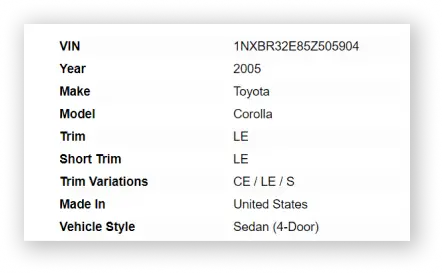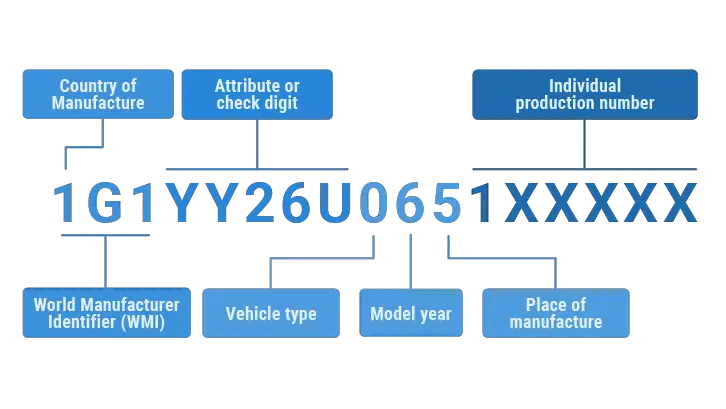Vehicle specs by VIN provide detailed information about a vehicle’s make, model, engine, and more. Decoding the VIN lets you verify its specifications quickly and accurately.
The Vehicle Identification Number (VIN) is one of the most important identifiers for any motor vehicle. Every vehicle on the road today has a unique 17-character VIN that holds essential details about the vehicle’s history, specifications, and characteristics. Whether you’re purchasing a car, selling a vehicle, or performing maintenance, understanding how to decode a VIN to reveal a vehicle’s specifications is crucial.
In this post, we will dive deep into what a VIN is, how to decode it, and how to interpret the specifications tied to it. We’ll also address common misconceptions about VINs and provide answers to some frequently asked questions to ensure you have all the information you need.

Contents
What Is a VIN?
A Vehicle Identification Number (VIN) is a unique 17-character alphanumeric code used to identify individual vehicles. This number is assigned by the manufacturer and is used worldwide to track a vehicle’s identity. Think of it as the fingerprint of a car – it’s unique to each one and provides a wealth of information about the vehicle.
The VIN is designed to be standardized, with a set pattern that allows decoding to extract vital information. It includes everything from the make and model of the vehicle to where it was manufactured and its unique features.
Structure of a VIN
The 17 characters in a VIN are not arbitrary. They are divided into three main sections:
- World Manufacturer Identifier (WMI) – The first three characters identify the vehicle’s manufacturer and its country of origin. For example, “1” is used for the United States, “2” for Canada, and “J” for Japan.
- Vehicle Descriptor Section (VDS) – Characters 4 to 9 describe the vehicle’s model, body type, engine, restraint systems, and more. These characters reveal the vehicle’s specific design and configuration.
- Vehicle Identifier Section (VIS) – Characters 10 to 17 provide information about the vehicle’s model year, assembly plant, and serial number. This is how manufacturers uniquely identify individual vehicles in their production lines.

Why Is VIN Decoding Important?
Decoding a vehicle’s VIN is essential for verifying its specifications, history, and authenticity. It helps buyers, sellers, and service providers ensure the vehicle matches the described features and is free from hidden issues.
For Buyers
When purchasing a used vehicle, one of the most important steps you can take is to decode the VIN. Doing so can help you verify the vehicle’s authenticity, confirm its specifications, and even check if it has been in any major accidents. By knowing the vehicle’s exact model, make, year, and specifications, you can ensure that the car matches what the seller claims.
For buyers, a VIN check can help avoid purchasing a car with undisclosed issues like flood damage, accident history, or mileage discrepancies. It can also help you confirm the car’s engine type and transmission before committing to a purchase.
For Sellers
Sellers can benefit from providing a VIN to potential buyers. By offering the decoded specifications upfront, sellers can build trust and transparency in the sales process. Whether you’re selling through a dealership or privately, sharing a decoded VIN helps the buyer verify the vehicle’s details, streamlining the sale. Read more about Car Value by VIN Number
For Mechanics and Service Providers
VIN decoding is also useful for service providers. By knowing the exact specifications of the vehicle, mechanics can ensure they are using the correct parts when performing maintenance or repairs. This ensures compatibility and prevents costly mistakes when dealing with complex systems, such as the engine, transmission, or electrical systems.
For Law Enforcement
In addition to its use for buyers, sellers, and mechanics, VIN decoding is vital for law enforcement. It helps authorities track stolen vehicles and identify those involved in illegal activities. The VIN allows officers to quickly verify the vehicle’s history and ensure it’s not been tampered with or involved in any criminal activity.
How to Decode a VIN
Decoding a VIN allows you to access important details about a vehicle’s make, model, engine, and more. This process helps you verify specifications and ensure you’re getting accurate information about the vehicle.
Step 1: Locate the VIN
The VIN is typically located in several places on a vehicle, and it’s essential to know where to look to access it:
- On the Dashboard: The most common location is on the driver’s side of the dashboard, near the windshield. You can see it from outside the car, through the windshield.
- On the Driver’s Side Door Frame: Open the driver’s side door, and look on the frame near the door latch. There should be a small metal plate or decal with the VIN on it.
- On the Engine Block: In some cases, the VIN is also stamped into the engine block. This is usually harder to access but can be useful if other VIN locations are damaged or difficult to read.
Step 2: Use an Online VIN Decoder
Once you have located the VIN, the next step is to decode it. There are numerous online tools and services available to help you decode a VIN and reveal the vehicle’s specifications.
- National Highway Traffic Safety Administration (NHTSA) VIN Decoder: One of the most authoritative and widely used tools, the NHTSA VIN decoder provides a comprehensive breakdown of the VIN, showing the make, model, engine type, and more.
- AutoZone VIN Decoder: A user-friendly tool offered by AutoZone, providing detailed information on the car’s parts and specifications.
- Carfax or AutoCheck Reports: Both Carfax and AutoCheck provide a comprehensive history report tied to the VIN, which includes accident history, service records, and more. These are paid services, but they can give you more in-depth insights about the vehicle’s past.
- Manufacturer-Specific VIN Lookup Tools: Many vehicle manufacturers, such as Toyota or Ford, offer their own VIN decoders on their websites. These are highly accurate and tailored to that manufacturer’s vehicles.
Step 3: Interpret the Decoded Information
After entering the VIN into a decoder, you’ll receive a report that includes information like:
- Make and Model: The car’s manufacturer and specific model, such as “Toyota Camry” or “Ford F-150.”
- Engine Type: Information about the vehicle’s engine, including the engine size (e.g., 3.5L V6) and configuration (e.g., hybrid or turbocharged).
- Transmission: The type of transmission in the vehicle, whether automatic, manual, or semi-automatic.
- Body Style: Whether the vehicle is a sedan, SUV, truck, coupe, or another body type.
- Manufacturing Location: This indicates where the car was built (for example, “Made in Japan” or “Assembled in the USA”).
- Model Year: The year the vehicle was manufactured.
- Safety Features: Information about the vehicle’s airbags, seatbelts, and other safety features.
By interpreting this data, you can confirm that the vehicle matches the specifications provided by the seller and check for potential red flags.
Common Misconceptions About VIN Decoding
There are several myths surrounding VIN decoding that can lead to confusion or misunderstandings. In this section, we’ll address these common misconceptions and clarify the truth behind them.
1. VIN Decoding Only Helps with Used Vehicles
Although VIN decoding is crucial for used vehicles, it is equally useful for new cars. When buying a new vehicle, you can still use the VIN to confirm the car’s exact model, features, and specifications. This helps ensure that the car matches the features you’re looking for, such as color, trim package, or even specific engine options.
2. All VIN Decoders Provide the Same Information
Not all VIN decoders offer the same level of detail. Some provide only basic information, like the make and model, while others offer more in-depth reports, including vehicle history, accident records, and details about specific parts. It’s essential to choose a reputable and thorough VIN decoding tool to ensure you’re getting accurate information.
3. VINs Are Only for Vehicle Registration
While it’s true that the VIN is used for vehicle registration, it holds much more information. It’s not just an identifier; it’s a gateway to understanding the full specifications, features, and history of a vehicle. This makes the VIN an essential tool for anyone involved in purchasing, selling, or maintaining a car.
Frequently Asked Questions
Here are some FAQs about vehicle specs by VIN –
1. Can a VIN Tell Me if a Vehicle Has Been in an Accident?
Yes, decoding the VIN can sometimes help you determine if a vehicle has been in an accident, especially if you use services like Carfax or AutoCheck, which provide vehicle history reports. These reports include information about past accidents, repairs, and any claims made on the vehicle.
2. Is It Legal to Decode a VIN?
Yes, it is completely legal to decode a VIN. In fact, VIN decoding is a common practice for both buyers and service providers to verify vehicle details and specifications.
3. Can I Decode a VIN for Any Vehicle?
Most online VIN decoders work for all vehicles, regardless of make or model. However, certain decoders may be specific to certain brands, such as Ford, Toyota, or Honda. If you are looking for detailed information for a specific brand, it’s best to use the manufacturer’s official decoder tool.
4. Do I Need the Full 17-Character VIN to Decode It?
Yes, to get accurate and detailed specifications, you need the full 17-character VIN. This unique code contains the precise details about the vehicle, and entering a partial VIN will result in incomplete or incorrect information.
5. Are There Any Fees for Using VIN Decoders?
Many basic VIN decoders are free to use. However, if you want to access more in-depth reports, such as a vehicle history or a detailed specification breakdown, services like Carfax or AutoCheck may charge a fee.
Related Article
Towing Capacity by VIN
Paint Code by VIN Number
Ford Window Sticker by VIN
Conclusion
Decoding a VIN is an essential skill for any car buyer, seller, mechanic, or enthusiast. The 17-character code embedded in every vehicle provides a wealth of information about the car, including its specifications, manufacturing details, and even its history. By learning how to decode this vital piece of information, you can make more informed decisions when purchasing, selling, or servicing vehicles.
Whether you’re checking a used car’s history, ensuring your maintenance is done correctly, or simply verifying a vehicle’s details before purchase, VIN decoding is a tool you shouldn’t overlook. Make sure to use reliable VIN decoders, like those provided by manufacturers, the NHTSA, or Carfax, to get accurate and detailed information about the vehicle you’re dealing with.
If you’re ready to decode your vehicle’s VIN, start by visiting a VIN decoder tool like the NHTSA VIN Decoder at nhtsa.gov to access all the details you need.